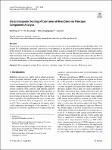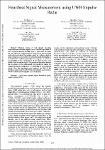Tìm kiếm
Chủ đề
- Airplane testing (1)
- biomedical signal (1)
- Deep learning (1)
- Electromagnetic testing (1)
- Sau >
Kết quả tìm kiếm
Detection of corrosion at rivet sites in a multilayer structure of an aircraft is an essential task to ensure the flight safety of an aircraft. It is challenging to detect the corrosion due to the influence on the signal of the rivet and the multiple fastened layers in the structure. In this letter, an electromagnetic testing method is used in conjunction with principal component analysis (PCA) to detect corrosion around fasteners. Multiple Hall sensors were used for efficient measurement of the magnetic field distribution at the rivet sites. The features of the scanned magnetic image were automatically extracted by the PCA in orthogonal subspaces. The proposed method shows potential results of features extraction and corrosion signal extraction for further development of electromag... |
Magnetic flux leakage testing (MFLT) is an important nondestructive testing method for the detection and evaluation of defects in magnetic materials. Magnetic field distribution in an MFLT system is usually simulated by the finite element method (FEM), which required large memory, high computation, and complication of the meshing process. In this paper, an alternative simulation method will be proposed using a deep neural network (DNN). The DNN method provides an easy way of simulation by feeding only the distribution of supplied current and the physical properties such as magnetic permeability without the need for the meshing process. Defects with arbitrary sizes were simulated under different configurations of the MFLT systems. The DNN was trained on the simulation results of the ... |
Remote sensing of vital signals, including respiration and heartbeat signals, is an essential application of ultra-wideband impulse (UWB) radar. UWB radar measures the vital signal by a small motion of the thorax in the breathing and cardiac activities. The motion caused by cardiac activity is small compared to the motion of respiration and challenging to be detected in a real-life application. In this paper, we propose an algorithm for the enhancement of the signal-to-noise ratio (SNR) of the heartbeat signal. The proposed algorithm analyzes the correlation of the multichannel vital signals for taking the common harmonic component corresponding to the heartbeat signal. Thus, the algorithm could improve the SNR of the heartbeat signal over the referenced methods such as continuous w... |



